Injection Mixtures 101
#1
Injection Mixtures 101
I have seen countless threads started to find out what injection mixture is best. Or what mixture produces more Power/Torque. It is obvious; searching is still producing limited answers with limited experience to back such claims.
There is no need for a master degree in chemistry to understand the effects of what different mixtures can produce or provide. Wikipedia has an excellent write up about water injection in general. http://en.wikipedia.org/wiki/Water_injection_(engines)
This should be read and understood before we go any further.
I will cover the three main mixtures most commonly used:
1. 100% Methanol
2. 100% Water
3. 50/50 Methanol/Water
Methanol aka Meth is combustible and has a lower viscosity than water. Meth’s viscosity is [cP] 0.544 Water’s viscosity is [cP] 0.894. Meth also has a very low surface tension, 20 dyne/cm compared to water, 70dyne/cm. Liquids with higher viscosities will not make such a splash when poured at the same velocity
SLOWCAR had a perfect example, if you have poured meth before you will notice it is harder to pour and keep straight without splashing vs. water due to lower viscosity.
Those two properties of Methanol make it more capable of even cylinder distribution than water. Also meth has a better atomization than water allowing for more heat to be removed from the air allowing cooler air intake temps.
Methanol has a high octane rating and can help increase power due to this increase in detonation control. Meth’s octane rating depends a lot on how it is measured. Various reports give methanol different values, but 115 octane seems about typical. This really only has an effect on pre-detonation lowering the probability of predet to occur. Lack of knock will be due to the cooler air temps and the added “fuel”(meth) in the cylinder, but not the octane rating as it has little to due with the deflagration burn and primarily to do with the detonation burn in which it tries to prevent hence a high octane rating. Running 100% methanol is easy to tune and make great additional power; turn up the boost, up the timing and lean it out a bit. Because of the this easy to tune and use method, it makes it to be the favorite of a lot of tuners.
One of the drawbacks of methanol is that it’s corrosive to aluminum. Methanol, although a weak acid, attacks the oxide coating that normally protects the aluminum from corrosion. This has yet to prove to be a big problem when it is used as an additive vs fuel source, but should be looked at as a possible long term problem.
Another side effect of Meth is the amount needed to that of a 50/50 mix is double! And triple that of 100% water! When looking at cost $35 for 5 gallons of VP M1 Say that lasts you 4 weeks. With a 50/50 mix 5 gallons could in theory last twice as long! In one year Expect $420 to be spent on meth. Expect $240 on 50/50 mixture.
Great caution is to be used with 100% Methanol. Here is a Warning given by Aquamist’s Richard L:
WARNING:
Great care must be exercised when 100% methanol is used.
1) The system must be checked for smallest leaks. Any electrical spark will start a fire.
2) Breather hole from the tank must be vented outside the car, well away from the exhaust pipe. If the correct air/methanol concentration is attained during the incoming air occupying the void left by the deminishing methanol level inside the tank. It can potentially be quite explosive.
3) All electrical connections must be terminated properly, avoid any sparkes being generated.
4) The tank area must be well ventilated in case some methanol is spilled during re-filling. I strongly suggesting using a remote filler cap, positioned well away from carpet or any fluid absorbing materials such as trunk lining or carpets. You can get them from: http://fluids.flambeau.com/component...er_spouts.html
5) Common sense is essential and don't take any risk.
Water is not combustible and has an infinite octane rating since it can’t detonate.
Water provides the most effective cooling due to its great density and high heat absorption properties. Water has the second highest specific heat capacity of any known chemical compound on earth! This allows for cooler in-cylinder temps and exhaust gas temps and far superior knock suppressing than anything else! But in order to see the true benefit (power/torque) of 100% water you have to run extreme boost levels (30psi +) along with insane timing (8+* +) and extremely lean afrs (12.5*’s) because the water allows you to do so safely (lol).
A draw back to doing that is obvious;
One: if the system was to fail and not produce the water flow needed, it will result in total engine failure from the extreme levels almost immediately and a failsafe won’t have much control due to the extremes of every aspect of the given tune situation.
Two: Water sticks to itself. Water has a high surface tension caused by the strong cohesion between water molecules because it is polar. Water also has high adhesion properties because of its polar nature. All that simply means it will not spread evenly to every cylinder and does not atomize as well as say meth, so it can cause certain cylinders to run dangerous and some not.
SLOWCAR showed the benefits and the draw backs of a 100% water system.
On 87 octane and high boost with lean Afrs and high timing he managed 350+ whp on a Mustang dyno! All that on a STOCK Evo 8 motor and turbo!!! What was the draw back? The water did not distribute evenly causing a cylinder to run extremely lean and cause total engine failure.
Rally cars use 100% water for that benefit but have got it to distribute evenly and reliably. They use water because of its ability to cool. Since rally cars rarely see high speeds they rarely get the penetration to cool bigger intercoolers and radiators so they needed a subsidiary, Water. WRC teams have been known to produce 40 psi 8+* of timing and 12.5* Afrs making 350 whp and near 500 wtq! All that with 100% water injection.
Ok you have made it this far. You now understand both the benefits and the drawbacks to both 100% Methanol and %100 Water. 50/50 in simple terms takes the benefits of both meth and water, combines them and looses the drawbacks. With meth you get the cooler air temps, higher octane (predet control), and the greater atomization and even distribution. With the water you greatly reduced knock, reduced in-cylinder temps (40* or more), Lower egts, its less corrosive and get the cost effectiveness (lasts longer). With both you can make safer more reliable and consistent results in power, torque and reliability. Don’t forget the money you save over race fuel .
.
But this all comes with a buyer beware: Each car is different, each tuner is different, and each kit is different, therefore each result will be different to a degree. Find a tuner who is confident about each one of these mixtures, who can tune each one and who knows the effects of these various mixtures. For further discussion also research how these mixtures are distributed as that makes a crucial difference as well. I’m biased and will say Aquamist is the best but it’s all up to you in the end.
Richard from Aquamist, The Pioneers of water injection for the Auto industry has an excellent review of the effects of different mixtures. And I quote:
^^^To that: I finish this. Good luck, be smart and safe in the choosing these important decisions on your quest for power. I hope I have help some decide or at least understand injection mixtures a little more. I believe this information to be true and accurate to the best of my knowledge.
Evan Smith
Special thanks to:
Richard L from Aquamist
Abner aka Slowcar
There is no need for a master degree in chemistry to understand the effects of what different mixtures can produce or provide. Wikipedia has an excellent write up about water injection in general. http://en.wikipedia.org/wiki/Water_injection_(engines)
This should be read and understood before we go any further.
I will cover the three main mixtures most commonly used:
1. 100% Methanol
2. 100% Water
3. 50/50 Methanol/Water
100% Methanol (CH3OH)
Methanol aka Meth is combustible and has a lower viscosity than water. Meth’s viscosity is [cP] 0.544 Water’s viscosity is [cP] 0.894. Meth also has a very low surface tension, 20 dyne/cm compared to water, 70dyne/cm. Liquids with higher viscosities will not make such a splash when poured at the same velocity
SLOWCAR had a perfect example, if you have poured meth before you will notice it is harder to pour and keep straight without splashing vs. water due to lower viscosity.
Those two properties of Methanol make it more capable of even cylinder distribution than water. Also meth has a better atomization than water allowing for more heat to be removed from the air allowing cooler air intake temps.
Methanol has a high octane rating and can help increase power due to this increase in detonation control. Meth’s octane rating depends a lot on how it is measured. Various reports give methanol different values, but 115 octane seems about typical. This really only has an effect on pre-detonation lowering the probability of predet to occur. Lack of knock will be due to the cooler air temps and the added “fuel”(meth) in the cylinder, but not the octane rating as it has little to due with the deflagration burn and primarily to do with the detonation burn in which it tries to prevent hence a high octane rating. Running 100% methanol is easy to tune and make great additional power; turn up the boost, up the timing and lean it out a bit. Because of the this easy to tune and use method, it makes it to be the favorite of a lot of tuners.
One of the drawbacks of methanol is that it’s corrosive to aluminum. Methanol, although a weak acid, attacks the oxide coating that normally protects the aluminum from corrosion. This has yet to prove to be a big problem when it is used as an additive vs fuel source, but should be looked at as a possible long term problem.
Another side effect of Meth is the amount needed to that of a 50/50 mix is double! And triple that of 100% water! When looking at cost $35 for 5 gallons of VP M1 Say that lasts you 4 weeks. With a 50/50 mix 5 gallons could in theory last twice as long! In one year Expect $420 to be spent on meth. Expect $240 on 50/50 mixture.
Great caution is to be used with 100% Methanol. Here is a Warning given by Aquamist’s Richard L:
WARNING:
Great care must be exercised when 100% methanol is used.
1) The system must be checked for smallest leaks. Any electrical spark will start a fire.
2) Breather hole from the tank must be vented outside the car, well away from the exhaust pipe. If the correct air/methanol concentration is attained during the incoming air occupying the void left by the deminishing methanol level inside the tank. It can potentially be quite explosive.
3) All electrical connections must be terminated properly, avoid any sparkes being generated.
4) The tank area must be well ventilated in case some methanol is spilled during re-filling. I strongly suggesting using a remote filler cap, positioned well away from carpet or any fluid absorbing materials such as trunk lining or carpets. You can get them from: http://fluids.flambeau.com/component...er_spouts.html
5) Common sense is essential and don't take any risk.
100% Water (H2O)
Water is not combustible and has an infinite octane rating since it can’t detonate.
Water provides the most effective cooling due to its great density and high heat absorption properties. Water has the second highest specific heat capacity of any known chemical compound on earth! This allows for cooler in-cylinder temps and exhaust gas temps and far superior knock suppressing than anything else! But in order to see the true benefit (power/torque) of 100% water you have to run extreme boost levels (30psi +) along with insane timing (8+* +) and extremely lean afrs (12.5*’s) because the water allows you to do so safely (lol).
A draw back to doing that is obvious;
One: if the system was to fail and not produce the water flow needed, it will result in total engine failure from the extreme levels almost immediately and a failsafe won’t have much control due to the extremes of every aspect of the given tune situation.
Two: Water sticks to itself. Water has a high surface tension caused by the strong cohesion between water molecules because it is polar. Water also has high adhesion properties because of its polar nature. All that simply means it will not spread evenly to every cylinder and does not atomize as well as say meth, so it can cause certain cylinders to run dangerous and some not.
SLOWCAR showed the benefits and the draw backs of a 100% water system.
On 87 octane and high boost with lean Afrs and high timing he managed 350+ whp on a Mustang dyno! All that on a STOCK Evo 8 motor and turbo!!! What was the draw back? The water did not distribute evenly causing a cylinder to run extremely lean and cause total engine failure.
Rally cars use 100% water for that benefit but have got it to distribute evenly and reliably. They use water because of its ability to cool. Since rally cars rarely see high speeds they rarely get the penetration to cool bigger intercoolers and radiators so they needed a subsidiary, Water. WRC teams have been known to produce 40 psi 8+* of timing and 12.5* Afrs making 350 whp and near 500 wtq! All that with 100% water injection.
50/50 Water (H2O) & Methanol (CH3OH)
Ok you have made it this far. You now understand both the benefits and the drawbacks to both 100% Methanol and %100 Water. 50/50 in simple terms takes the benefits of both meth and water, combines them and looses the drawbacks. With meth you get the cooler air temps, higher octane (predet control), and the greater atomization and even distribution. With the water you greatly reduced knock, reduced in-cylinder temps (40* or more), Lower egts, its less corrosive and get the cost effectiveness (lasts longer). With both you can make safer more reliable and consistent results in power, torque and reliability. Don’t forget the money you save over race fuel
 .
.But this all comes with a buyer beware: Each car is different, each tuner is different, and each kit is different, therefore each result will be different to a degree. Find a tuner who is confident about each one of these mixtures, who can tune each one and who knows the effects of these various mixtures. For further discussion also research how these mixtures are distributed as that makes a crucial difference as well. I’m biased and will say Aquamist is the best but it’s all up to you in the end.
Richard from Aquamist, The Pioneers of water injection for the Auto industry has an excellent review of the effects of different mixtures. And I quote:
The following charts are calculated based on:
10Kg of air, Gasoline's latent heat capacity of 350KJ/Kg
Water's latent heat capacity of 2256KJ/Kg
Methanol's latent heat capacity of 1109KJ/Kg
Injection water at different ratio to fuel at 100% water and 75% Water/25% Methanol. You can see the at 100% water injection, only 3% of w/f fuel ratio is enough to replace 2.5 point of a/f ratio (dotted line). As soon as 25% of Methanol is added, the a/f ratio is dropped to 12.0 - loosing some cooling capacity
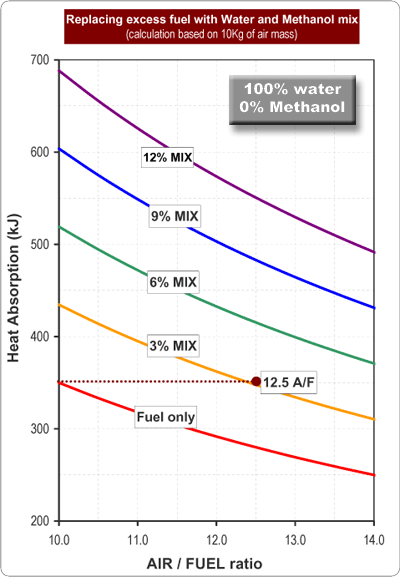
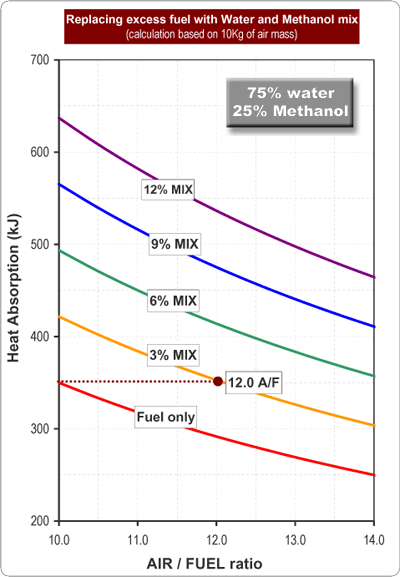
Each of the following chart show a 25% percent increase in Methanol concentration of the mix.
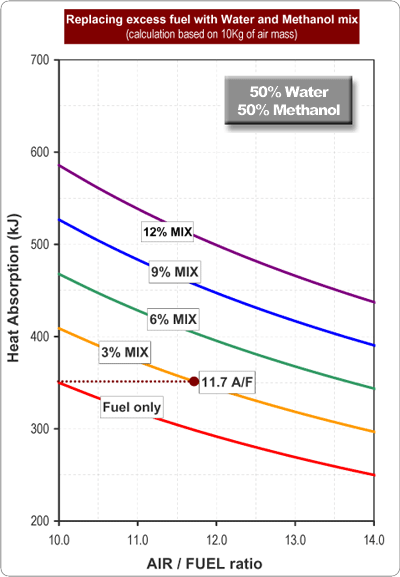
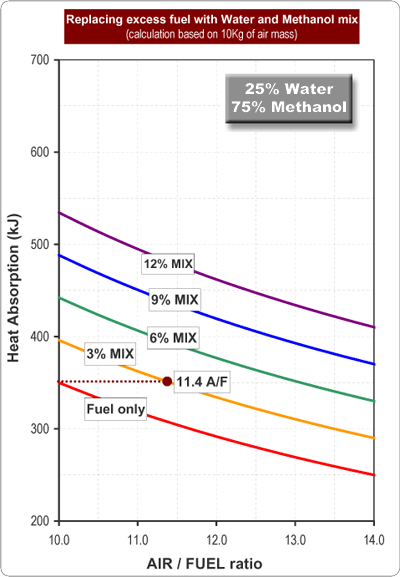
lastly, just methanol is added and no water. The chart on the right is 100% water
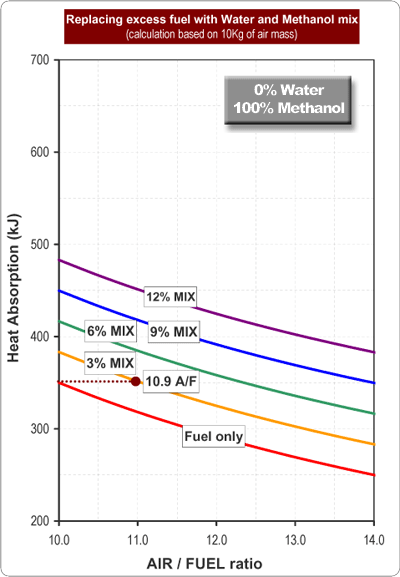

The two charts show (first and last) that you will be required to inject twice the amount of methanol to equal the latent heat of water alone. Methanol is relatively low cost and very effective as a coolant so what is the problem?
When higher concentration of methanol is injected, you need to lean your engines a/f ratio to accommodate the extra fuel or your engine will bog down and loose power. Consequentially - one runs the risk of putting the engine into heat stress if the supply of methanol is suddenly interrupted. Injecting water does not affect the a/f ratio. It appears that 50/50 mix has the best of both worlds.
In either cases, having a good w/a injection system with reliable "system fault" diagnostic capability is essential especially if you are running a high concentration of Methanol.
10Kg of air, Gasoline's latent heat capacity of 350KJ/Kg
Water's latent heat capacity of 2256KJ/Kg
Methanol's latent heat capacity of 1109KJ/Kg
Injection water at different ratio to fuel at 100% water and 75% Water/25% Methanol. You can see the at 100% water injection, only 3% of w/f fuel ratio is enough to replace 2.5 point of a/f ratio (dotted line). As soon as 25% of Methanol is added, the a/f ratio is dropped to 12.0 - loosing some cooling capacity


Each of the following chart show a 25% percent increase in Methanol concentration of the mix.


lastly, just methanol is added and no water. The chart on the right is 100% water


The two charts show (first and last) that you will be required to inject twice the amount of methanol to equal the latent heat of water alone. Methanol is relatively low cost and very effective as a coolant so what is the problem?
When higher concentration of methanol is injected, you need to lean your engines a/f ratio to accommodate the extra fuel or your engine will bog down and loose power. Consequentially - one runs the risk of putting the engine into heat stress if the supply of methanol is suddenly interrupted. Injecting water does not affect the a/f ratio. It appears that 50/50 mix has the best of both worlds.
In either cases, having a good w/a injection system with reliable "system fault" diagnostic capability is essential especially if you are running a high concentration of Methanol.
Evan Smith
Special thanks to:
Richard L from Aquamist
Abner aka Slowcar
Last edited by esevo; Feb 5, 2010 at 07:59 AM.
The following users liked this post:
MicRX (Aug 27, 2022)
#4
Evolved Member
iTrader: (9)
Thanks
One thing I did not notice, unless I skipped it - sorry if I did, was the relavant changes of peak pressure off spark lead from addition of water and methanol, but mostly water. As H2O conc goes up it slows things down, so it has a retarding effect. One more, but not as significant, thing - methanol propagation rate is faster than gas at higher rpms, but not as much near peak load or lower rpm and might even be slower (flatter timing profile). But this a 100% gas vs 100% methanol comparison, so the relavent amount spryed probably aint that significant anyway. Good to be aware of though. The water part however is significant, to see for yourself spray some coming off of stright fuel without changing anything and watch the rpm slope fall.
One more thing, most of the power in combustion is obtained later on in a second flame during CO oxidation to CO2 and water is required for the process. How much is needed? Who the hell knows, but for those who run 100% it might be worthwhile (and for other reasons too) to give 90% a try
OT: Has anyone successfully logged flow yet and what system? I mean 0.0v when not spraying. I am searching for a loggable 0 - 5vdc flow sensor output for use with LogWorks via sensor signal interface
One thing I did not notice, unless I skipped it - sorry if I did, was the relavant changes of peak pressure off spark lead from addition of water and methanol, but mostly water. As H2O conc goes up it slows things down, so it has a retarding effect. One more, but not as significant, thing - methanol propagation rate is faster than gas at higher rpms, but not as much near peak load or lower rpm and might even be slower (flatter timing profile). But this a 100% gas vs 100% methanol comparison, so the relavent amount spryed probably aint that significant anyway. Good to be aware of though. The water part however is significant, to see for yourself spray some coming off of stright fuel without changing anything and watch the rpm slope fall.
One more thing, most of the power in combustion is obtained later on in a second flame during CO oxidation to CO2 and water is required for the process. How much is needed? Who the hell knows, but for those who run 100% it might be worthwhile (and for other reasons too) to give 90% a try

OT: Has anyone successfully logged flow yet and what system? I mean 0.0v when not spraying. I am searching for a loggable 0 - 5vdc flow sensor output for use with LogWorks via sensor signal interface
Trending Topics
#8
Evolved Member
iTrader: (9)
One more thing, sorry - methanol is not like ethanol or isopropanol for exposure. It is much more harmful. Try to avoid getting it on your skin. This is hard to do, like you said due to it's characteristics - splashes all over the place. Keep the stuff away from kids reach
#9
Evolved Member
iTrader: (4)
Join Date: Sep 2003
Location: Kingdom of Saudi Arabia
Posts: 3,456
Likes: 0
Received 0 Likes
on
0 Posts
dudical26 logs his flow on his Aquamist HFS-5 with the DDS3 too, hope he sees this and chimes in.
https://www.evolutionm.net/forums/sh...64#post6191864
Let me explain the reason for the ~0.5v at standby.
The algorithm to translate the turbine speed to voltage is quite complex because the update rate has to be very fast. To avoid sofeware glitches, a norminal 0.5V signal is generated to confirm the well being of the sensor for the DDS3's failsafe circuitry.
The latest flow sensor's body is made of metal. It can also be serviced by the user.
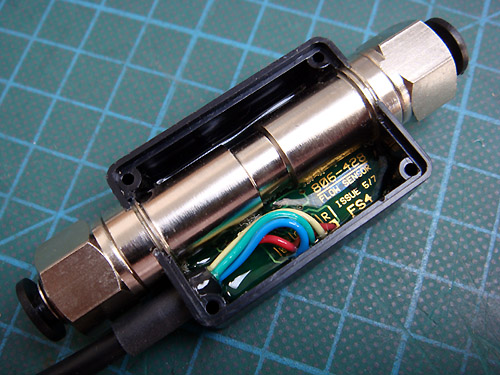
The algorithm to translate the turbine speed to voltage is quite complex because the update rate has to be very fast. To avoid sofeware glitches, a norminal 0.5V signal is generated to confirm the well being of the sensor for the DDS3's failsafe circuitry.
The latest flow sensor's body is made of metal. It can also be serviced by the user.

Last edited by SlowCar; Oct 4, 2008 at 02:29 PM.
#11
Evolved Member
iTrader: (17)
Join Date: Nov 2005
Location: NNJ
Posts: 2,544
Likes: 0
Received 0 Likes
on
0 Posts
i've been logging my Aquamist HFS-1 system via DDS3 flow sensing failsafe/Zeitronix for nearly 2 years.
dudical26 logs his flow on his Aquamist HFS-5 with the DDS3 too, hope he sees this and chimes in.
https://www.evolutionm.net/forums/sh...64#post6191864
dudical26 logs his flow on his Aquamist HFS-5 with the DDS3 too, hope he sees this and chimes in.
https://www.evolutionm.net/forums/sh...64#post6191864
Also, no need to tap the yellow wire, just feed another wire into the screw down block for the yellow wire.





